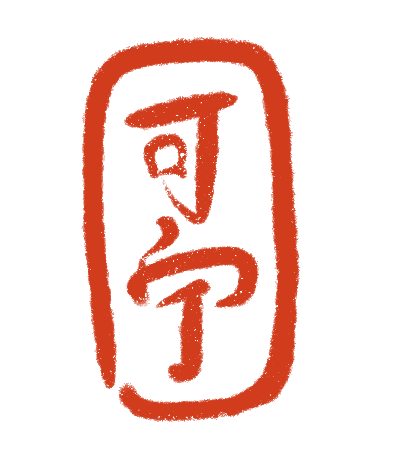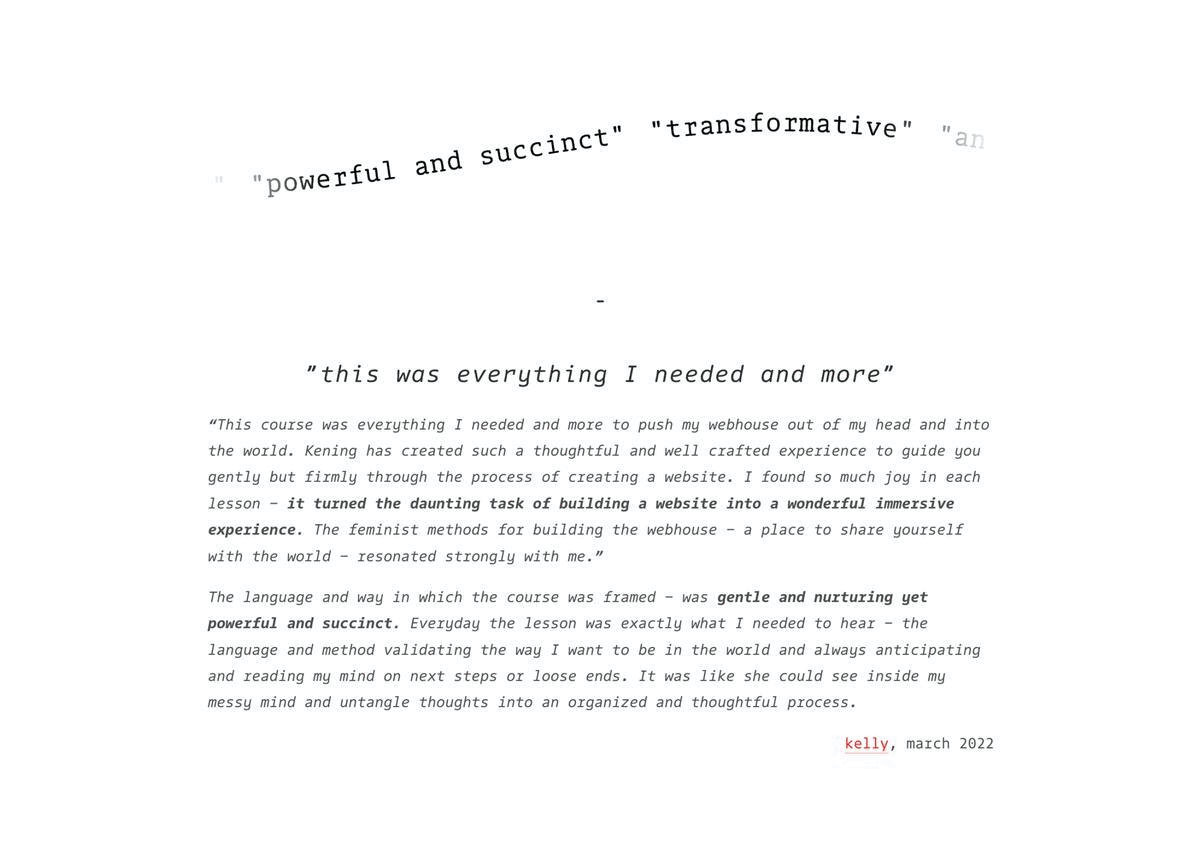dear creative friends,
this is guide.notes 07 ~ on the process of nurturing a creative life.
this week's letter is a very meta post about feeling overwhelmed by all the things. it's about creative procrastination, paralysis, and guilt - especially if you, like me, are prone to moodiness and getting lost in the wormhole of time. you cam read it here. 
let's pick a day of the week?
sheepishly speaking of which, I can't believe it's been two months since I wrote last! my commitment is to make this email weekly instead of whenever I feel a beeping alarm in my head. to help me with this, perhaps you could tell me which day of the week you'd like to hear from me?
what's inspired me lately
- this season's group in creative circle ❤️ such a special group that reminds me of why I do this work on the internet (which sometimes feels like a dark vortex of silence). but everytime I gather a group, the strangers that show up are ones I feel like I already know. your right people will find you. this is so hard to trust, but true.
- speed-reading money books - I started with happy money on the plane, then moved onto more hardcore "business" books that are not my ethos (with tones barely tolerable to read), but I found useful things to distill, integrate, and share with you, later.
- exploring what it's like to take nourishing internet walks - to travel by the speed of web (the rate of our curiosity & clicks) shall we say, instead of the mindless numbing scroll. (see an old post from 2019, when I was a little more radical, false nourishment vs. comfort
- this writer recommending food as writing nourishment
- the beauty of fresh artichokes, in spring.
- a poem I just read from poem-a-day - home goods by Janice Lobo Sapigao and it made me miss my mother (my parents also love discount shopping).
- this pomodoro tool, which I've used for many years now -- as an antidote to starting inertia and paralysis
- this BBE playlist and channeling boss-energy.
- thinking about visualizing the flavor notes of perfume/coffee/wine.
house on the webs price change
house on the webs is a 10 day website creation course I've taught for a few years now. the course distills the overwhelming process (of self-representation on the internet) into something easeful, smooth, and pleasurable. starting June 5th, I'll be changing the pricing structure:
- $450 -- for a self-paced course.
- $900 -- for 1:1 guidance and accountability with me, includes written comments + two 1:1, hour-long zoom sessions.
for the next 10 days, you can still purchase the course for the original price of $600, including all the TLC and private sessions with me.
here's the original house on the webs and school, on my website.
this week's post began as me identifying and proposing antidotes for my greatest blockage -- growing a creative business as an emotionally-driven artist — dealing with moods, cycles, and energy, creative procrastination, paralysis, inertia, and of course, guilt! it's a long note-to-self (like most things I write) that I hope will be of use to you, too.
read this on my site here
a moody creative's guide to work overwhelm

recently, I've been reflecting on my biggest blockages in growing my creative work and business over these last years. and I'd definitely say, it's being pushed around by my fluctuating emotions, sensitivity, and feelings of overwhelm.
in other words, I realized that I've been running my business as an emotionally-driven artist, not as an entrepreneur -- a mode of operation that's great for making art, but not great for making money, or building a sustainable business (which I'll define as: an exchange of value and energy with the world).
why? because building a business requires connection, accountability, and showing up consistently to serve your people -- even if your internal impulse is to disappear into a cave, disconnect, and hide under a rock. (that was me, for many years.)
working as a reaction to feelings
here's what I mean exactly. up until very recently, I mostly worked as an emotional response -- to whatever I was feeling, all-intensely, at the moment: to the external stress of client deadlines, to feelings of guilt towards my internal deadlines, or as a general desire to alleviate creative frustration/constipation.
without those feelings driving me, I procrastinated, because I was constantly craving the ideal conditions -- a feeling of time spaciousness and ease -- and as a result, I kept waiting, avoiding the work of showing up.
articulating this blockage has been ground-shifting for me, and so, in this post, I want to parse down and explore it further:
-
procrastination: the well-intentioned snooze
-
reaction: relieving discomfort and pain
-
on not letting your moods decide for you
-
a list of antidotes and solutions
the cycle of overwhelm
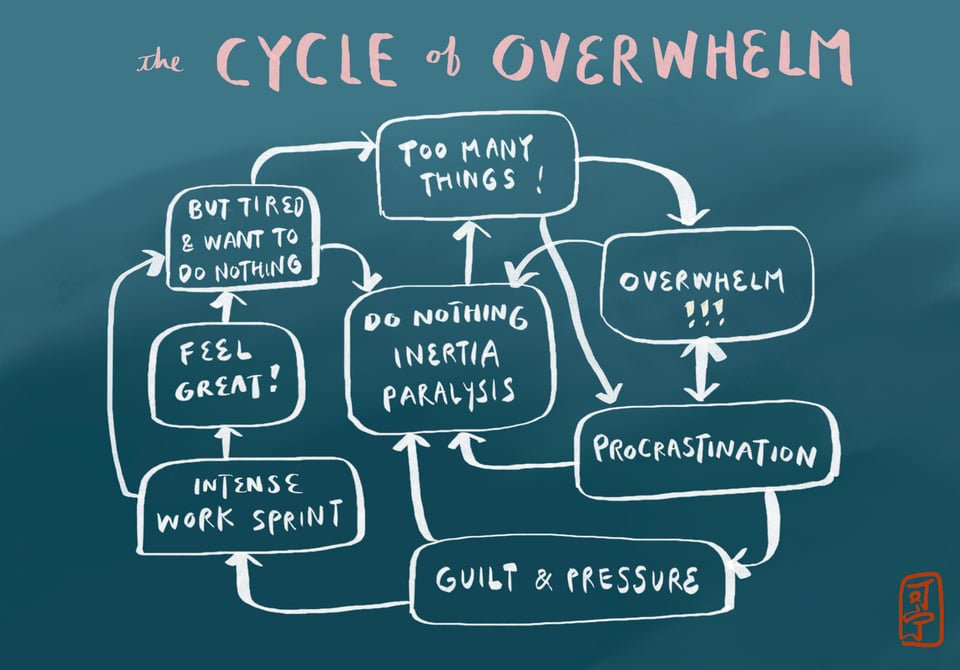
the well-intentioned snooze: procrastination
if the number one advice people give when starting any business is: show up and offer value, consistently - I definitely broke this rule a gazillion times, going months without sending newsletters, or weeks without posting anything, let alone responding to emails.
I've ghosted people unintentionally, not because I've forgotten about them -- quite the opposite -- but usually because I felt too emotionally consumed by other things; my head felt like a crowded, over-stimulated place, and I would struggle to carve out the quiet, calm, focus, spaciousness to do the thing, whatever that thing is.
I used my feelings of overwhelm to procrastinate. I always thought, "I'll get to it when I have more headspace." and over time, this way of responding to work tasks became a habit. it became a well-intentioned snooze. a form of creative paralysis.
the problem was: that headspace wouldn't come until 3 months later, if at all.
--
the reaction - relieving pain & discomfort
after the well-intentioned snooze, time passes. eventually, I'd probably end up tackling a task from accumulated feelings of guilt and constipation, internal clutter and chaos -- and not from a place of intention. I do the thing simply to alleviate my load, and get it out of my head. as in: "I must do A task in order to make more space in my head for B task."
how this habit of reactivity plays out
I did a creative project because it felt stagnant, and would die if I didn't push it out
I finally send newsletters months late, out of guilt.
I reply to emails from weeks (or months) ago, out of guilt.
I launch projects, courses & offerings that has been stuck in my head for at least half a year
in essence, I worked to relieve my own guilt for not working and not showing up consistently. because I was feeling overwhelmed by life, I didn't practice weekly routine tasks, or hold myself accountable to anything. instead, I'd slowly collect a backlog over weeks and months, until finally, I was walking around with a giant knot in my head.
moodiness and creative work
 (then do something else! come back later. see how you can reshape, reform, restructure your day to manage your moods. (speaking as an overly moody person).
(then do something else! come back later. see how you can reshape, reform, restructure your day to manage your moods. (speaking as an overly moody person).
--
in reflecting on my last years of being an artist -- I see that I've been prolific as a result of daily rituals and practices -- but not proactive, consistent, nor strategic about the housekeeping/business side of things: sharing work, selling offerings, sending newsletters — all the intimidating business system things that fall under “marketing and sales” — those concrete ways in which you serve others, and thus, transform creations to material wealth.
what I've learned, the hard way, is this -- I'll reiterate again:
you can make a body of creative work as a reaction to (sometimes overwhelming) moods & feelings, but you cannot run a business this way.
while making creative work might feel like riding an oceanic wave - it ebbs and flows with life - building a business is like growing a garden. it doesn't care about how bad the weather is. it just needs consistent care; someone to show up day in, day out and do the work. (this is related to: dream flowing vs. house-keeping)
you cannot grow a business by constantly juggling and responding to overwhelm, by doing things based on your changing moods.
my moods (life experiences, deep seated emotions and feelings, ie, mood diaries) have given me so much raw material for creation - and yet, it is always a double-edged sword. they overwhelm me, and prevent me from creating measurable, consistent growth.
I fall into the feelings -- and lose interest in all the other things that keep the engine running. this has been my greatest challenge these last years — and something I'm working on, everyday.
(note: don’t let your mood decide doesn’t mean - don’t listen to them. I’m the last person to suggest that!)
6 antidotes to overwhelm
so the question is: how? how can we embrace (not repress) our emotional bodies and cycles — while still holding ourselves accountable to concrete commitments? how can we work with that part of us that feels too sensitive, emotional, or soft to be a hardass business bitch — while still pushing ourselves to do the work?
is there a way to be in power with our moods & emotions -- instead of letting them override, overwhelm, and inhibit our growth?
I'd like to propose some possibilities:
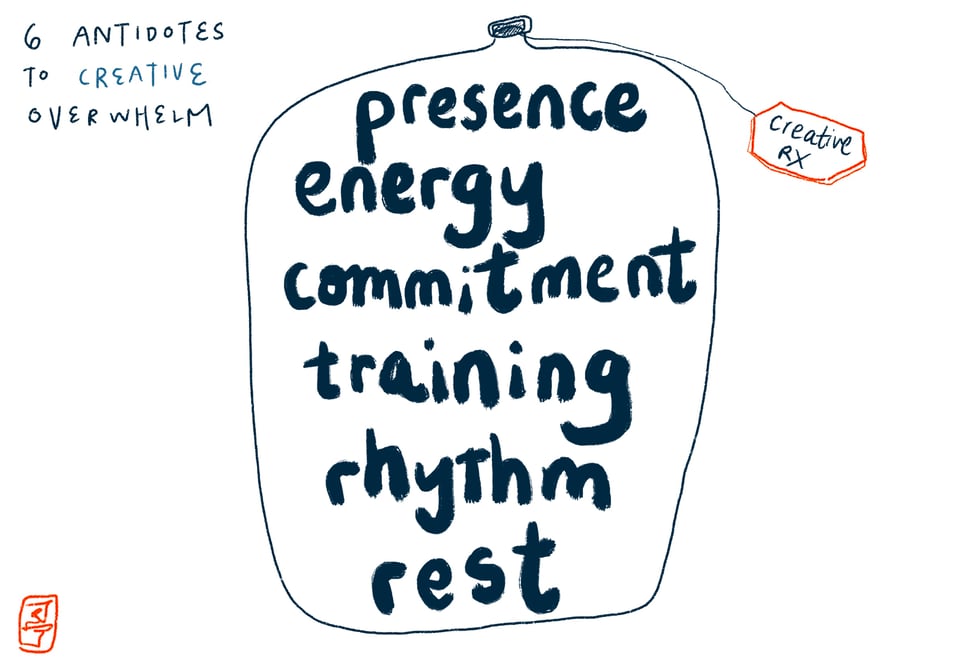
ANTIDOTE 1 - PRESENCE
Practice extreme presence with your emotions
giving space to my moods help me hold them, then eventually, release them. it's like having a metaphorical jar - if there is a designated space for whatever I'm feeling today, no matter how mundane, it's less likely to consume the rest of my life. instead of getting hairy, it stays contained — just because I’ve acknowledged it. but if I deny it, resist it, or complain about it, I'm more likely to waste the rest of my day in a headache, stressed-induced daze.
HOW TO DO THIS:
this could be as minimalist as setting aside 5-10 minutes a day to check in with yourself.
- how is your mind, heart, body feeling today?
- use a mood thermometer; ie, what's your mood on a scale of 1-10?
- write a few sentences about it.
- consider creating a creative vessel-container for it (like my moon journal, or mood diaries
ANTIDOTE 2 | ENERGY
Be attuned to your own energy budget
part of being a sensitive person is being easily affected by external stimuli. perhaps this means having low tolerance for crowded, noisy places, or watching movies before bed, or consuming too much Youtube or social media. the key is to be attuned to what gives you energy, and what depletes it -- plus all the more subtle gradations in between.
HOW TO DO THIS:
I use the tool of the energy log, which is as simple as making a list of all your activities, and adding a +, -, or o next to the activity for how much energy it takes or adds to your life. after a few days, evaluate which activities you'd like to do more of, and which less of.
the goal is to be always aware of your energy balance. if you wake up feeling depleted, to tend to your energy first before you try to expend it on work projects. do the projects that feed your energy first.
energy balance is not unlike bank balance. you must create money (and energy) before you spend it, or you'll be in energetic debt (leading to exhaustion and burn out). this is why a daily morning routine is so essential — to feed your energy daily.
ANTIDOTE 3 | COMMITMENT
Distill a commitment of extreme clarity
I see visions and commitments as two different things.
- your vision is the dream of what you want your life and work to be.
- your commitment is what you'll do to turn that dream into reality - everyday.
because the road of doing lonely work can feel so nebulous and uncertain - (and personally, I wake up with amnesia all the time) -- it's crucial that you distill your vision into a commitment of extreme clarity, and review it weekly, if not daily. you must be your own flame.
in other words, you must be both the general and the soldier. the soldier does not question the war; he trusts the general to his death. the general, in turn, must inspire confidence and unwavering loyalty.
HOW TO DO THIS:
- journal and distill down your purpose (your why, your desire, your dreams, your vision) into 1 index card sized note
- list out the goals that will bring you closer to manifesting this vision.
- distill them down into 1-2 commitments that you will do -- ideally a few times a week, if not daily.
write down exactly the reason why these commitments are absolutely crucial to building your vision.
if you're unsure, keep reflecting, absorbing, and journaling until you're convinced this is what you must do. this conviction is born from research, experience, and pure faith. keep doing this until you have your note-to-self down, with extreme, persuasive clarity -- you'll review this even on your most emotionally hungover days. this reminder is your magic potion.
ANTIDOTE 4 | TRAINING:
Train your muscle daily, and log your progress.
once you've distilled down your vision into commitments - 1-2 daily actions - restructure your life so that this commitment is your number one priority. it may not be the most urgent task -- but it IS the most important, even if there is no looming deadline, boss, or client waiting on the other side. this could be writing, creating, sharing, or connecting with others. the more detailed you are, of course, the better:
write everyday -- vs. -- spend 90 minutes writing every morning
you must convince yourself to make space for this commitment, until you find a rhythm, ritual, and system to make this commitment feel easy. think of it as training a muscle (or set of muscles).
if you're planning to run a marathon, you don't just wake up one day and decide to do it. your weekly training & cross-training schedule - over weeks or months, is an absolute imperative.
whatever action/commitment you choose, it must be the foundation that makes all other actions easier (and if you don't do it, it is also the bottleneck).
HOW TO DO THIS:
list your core 1-2 commitments, and reflect on these questions to build a ritual around it.
- what time of the day does it feel good to do this?
- what's my ideal execution of this look like?
- what's my bare minimum of time per day I can commit to, no matter what?
- how can I make this feel more effortless, and pleasurable?
- where and how can I keep track of my progress?
ANTIDOTE 5 | RHYTHM
align with your creative + sharing rhythms
being an artist in the world contains two distinct parts — creating and sharing. these are two different processes, with two different rhythms. what's a rhythm? a repeated ritual or habit that helps and support you to find the melody of inspiration, and finish singing the song. honor your own inner cycles.
while consistency sounds like a regular, linear output of something (weekly, monthly) -- perhaps your preferred creative rhythm is non-linear. maybe you work intensely for three days, or three weeks, then to take some time off. maybe you work better in short sprints. or, maybe you create three pieces of work, but only share two. or, you might work on a project for 4 hours, only to find your flow during the 5th hour. creative output and time are not always at a 1:1 ratio. you must get to know your own complex systems.
the key is to separate creating work from sharing work - as those are two completely different rhythms. (and ideally, the latter (sharing) is mostly automated, so that you can focus on the former (creating)).
HOW TO DO THIS:
experiment with different rhythms of creation (daily blocks, specific days of the week, short sprints) until you find a rhythm that feels nourishing and sustainable for you.
outline your processes for sharing, and make a commitment to keeping a sharing rhythm.
evolve and tweak this process into a template, until it takes as little energy as possible - over time.
now you're free to focus on creating.
ANTIDOTE 6 | REST
6 | REST resting = giving. give yourself windows of spaciousness, pleasure, and joy
intensive work takes time, energy, and a kind of extreme focus that can be all-consuming - thus, it's equally important to give yourself the opposite: days of doing nothing. maybe an hour a day of breathing space. early nights to bed. luxurious mornings (or nights) of spaciousness — to read, journal, dream; to counter balance the focus. this is how an intense pace of working can feel more sustainable. consider: what feels like rest vs. play vs. work, and all the gradations in between?
HOW TO DO THIS:
make a list of favorite things to do that make you feel spacious, and rested — that do not involve work. treat rest like your job.
- notice your windows of time where you experience energy dips.
- how can you give yourself the feeling of luxurious spaciousness in just 1 hour? 30 minutes? 10 minutes?
- can you incorporate those little breaks into your busiest days?
- how can you stay attuned to your psychic gas meter — that tells you when you need to take a day off? what are the clues from your body or emotional being?
*
end notes
it’s not about managing time - it's about managing energy, focus, and moods. time is finite, but the experience of it is also relative, cyclical, mysterious. the most we can do is to think about how to have a more abundant relationship with time — how to use it as a container for what truly needs our focus: quality of creative energy.
my suggestions boil down to 6 things:
- make space for your moods — with presence, patience, acceptance, and if you feel inspired — use creative containers. think of it as tracking inner weather. note it with curiosity.
- be attuned to your energy budget. keep an energy log. reduce down on depleting things, and add more sources of daily nourishment to your life. this is your fuel.
- distill your vision into 1-2 specific, daily commitments. this is what will get you closer to your goals; your daily workout. cultivate a routine, so that you don’t have to think about its execution.
- train your creative muscles daily. find your personal rhythms, pacing, and way of working. commit to becoming better at your daily actions until it feels more effortless.
- align and experiment with your rhythms for creating and sharing work.
- build in windows of rest and spaciousness through the day, and the week.
this is the process I've evolved (and am continually evolving) for myself. of course, what's most important is to find and experiment with whatever works for you -- this is a long path that only you can walk.
part of the essential skill is cultivating greater intimacy with your own inner metabolism - and seeing your moods, energy, and cycles as a source of power, not as a hinderance to that power 🔥
thank you for reading! write me back anytime.
some clairvoyant whispers of what's next
- a guide on embracing break-ups as rebirth
- on being a hermit-outsider building community
- a visual creations course
- a complete redesign of my website-world
your support helps me support you.
your support feeds my ecosystem, and allows me to make creation (and sharing the gems of its process) - a more sustainable way of living. your resources help me share my resources -- energy, soul, skill, time. thank you for any amount you'd like to give ♡ 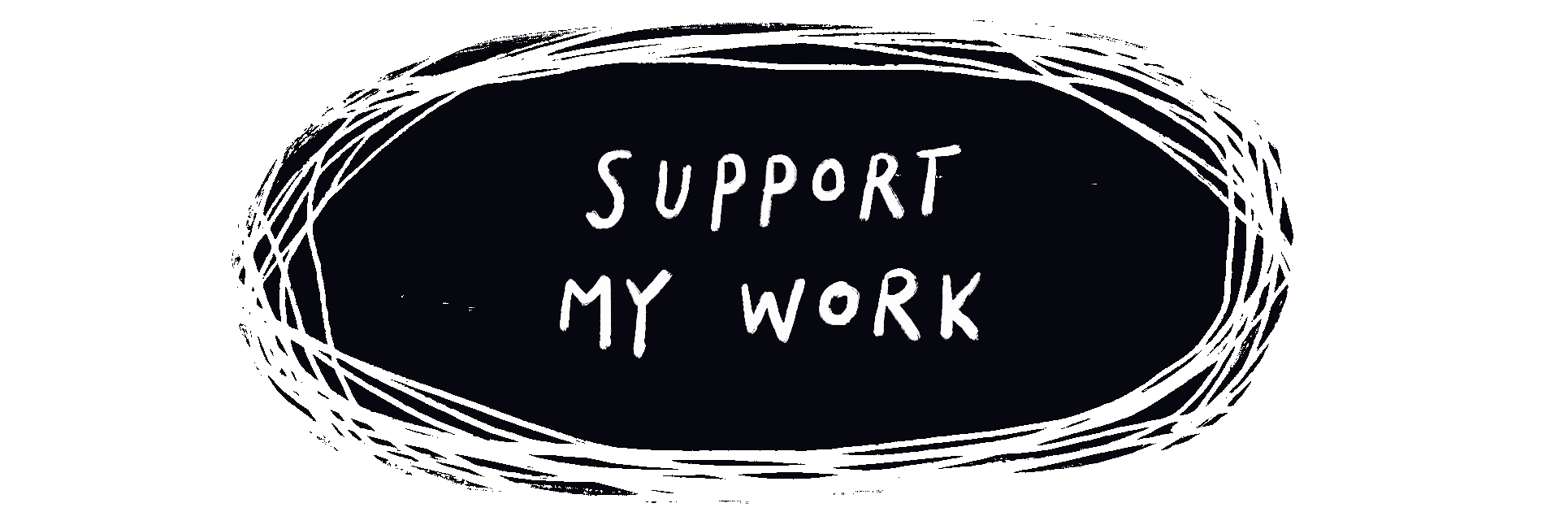
You just read issue #29 of kening's letters. You can also browse the full archives of this newsletter.
